#pteronura
Explore tagged Tumblr posts
Text
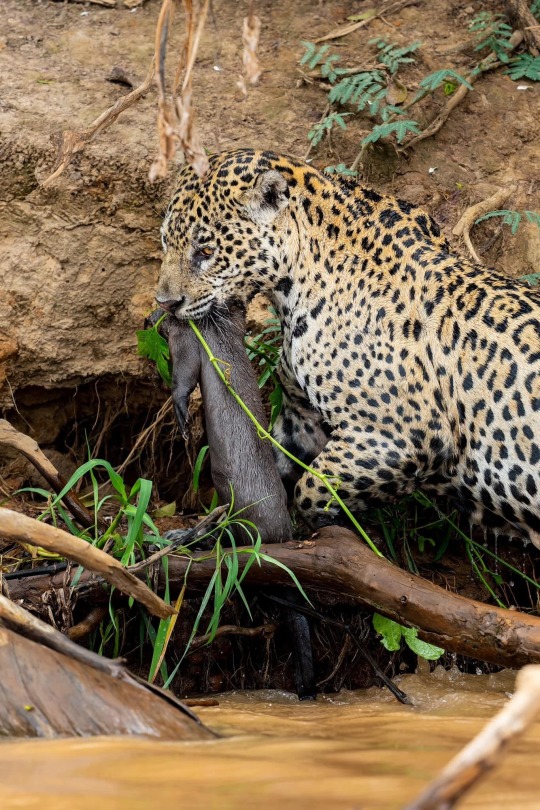
Jaguar with juvenile Giant Otter | Rodolfo Paz
#deceased#felidae#mustelidae#lutrinae#pantherinae#panthera#pteronura#panthera onca#pteronura brasiliensis#giant otter#jaguar#rodolfo paz
54 notes
·
View notes
Text

Giant Otter | Charlie Hamilton James
7 notes
·
View notes
Text

Giant Otters (Pteronura brasiliensis) - (c) SaritaWolf - please do not repost
3 notes
·
View notes
Text
Fishy Antics

A Giant Otter pursuing a fish in the former River Safari. Photo credit: Jonathan Chua.
It seemed that this fish had just escaped the jaws of the otter in the nick of time but it was really just a game. It was their feeding time and this otter and his family group had just gotten their fishes. The amusing thing was that they didn’t eat them right away but first played with the dead fishes. They would grab the fishes by their tails and push them in front of them as if they were chasing after them. One even held its fish facing itself and back paddled. It was so hilarious that I had missed capturing that moment.

Lighting was rather good actually but catching them in action was a little tricky with the contrast detection auto-focus system of the Olympus EM10 Mk II.
#photographers on tumblr#animal pics#flora fauna#giant otter photos#olympus em10 mkii#olympus photography#panasonic lumix 100-300mm#photography tips#Pteronura brasiliensis#wildlife photography
2 notes
·
View notes
Text

Well, that’s length-wise rather than height-wise, but yes! That would be the giant river otter (Pteronura brasiliensis), fellow countrymen of mine!


In fact, saying they’re 170 cm (5’7”) from head to tail is lowballing it a little. Some individuals as long as 180 cm (5’11”) have been recorded! Which is longer than I am tall 😔
You might have noticed that giant otters have a bit of a big cat-like look about themselves. That’s the origin of their name in Brazilian Portuguese, ariranha, which is a term from the Tupi-Guarani language and means “river jaguar”. And, just like ground jaguars, giant otters are apex predators as well: they mainly eat fish, but will hunt anything from snakes, turtles and even small caimans if given the opportunity!
Besides their size, giant otters have other traits that set them apart from their smaller cousins. For one, unlike most mustelids, they’re social animals who live in familial groups of up to twenty individuals, which whom they communicate constantly through a variety of different noises. Also, unlike other species of otter, whose tails are thick at the base and pointy at the end, giant otters’ tails also start out with a thick base, but they end up flat, which helps propel them through the water. The interesting thing about it, however, it’s that it’s not flat in an horizontal way, like the tails of other semiaquatic mammals such as beavers and platypuses. It’s flat vertically, not unlike the tail of a newt!

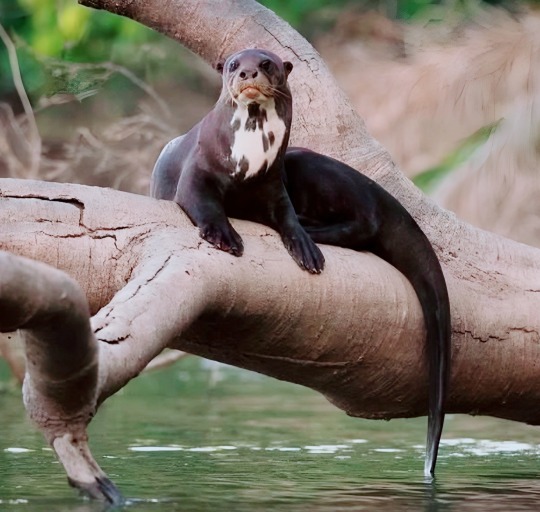
Source of the 2nd image: @resgateariranha on Instagram
#answers#animals#giant river otter#giant otter#otters#Also that probably goes without saying but you don’t want to mess with a mustelid this big.#They’re pretty territorial and as eager to voice their displeasure with you as your average American badger or wolverine.#And as social animals you’re never just dealing with one of them. You’re meeting their whole extended family!
9K notes
·
View notes
Text
Phylogenetic weasel tournament
Family: Mustelidae
Subfamily: Lutrinae, Mustelinae, Ictonychinae
Genus: Lontra, Hydrictis, Lutra, Lutrogale, Aonyx, Enhydra, Pteronura; Neogale, Mustela; Galictis, Lyncodon, Ictonyx, Poecilogale, Vormela






pictures: 1, 2, 3, 4, 5, 6
#polls#tournament poll#phylogenetic weasel tournament#mustelinae#ictonychinae#least weasel#marbled polecat#i'm an influencer now
440 notes
·
View notes
Text

Calle Eklund/V-wolf

Charles J. Sharp
The giant otter or giant river otter[4] (Pteronura brasiliensis) is a South American carnivorous mammal. It is the longest member of the weasel family, Mustelidae, a globally successful group of predators, reaching up to 1.8 m (5 ft 11 in). Atypical of mustelids, the giant otter is a social species, with family groups typically supporting three to eight members. The groups are centered on a dominant breeding pair and are extremely cohesive and cooperative. Although generally peaceful, the species is territorial, and aggression has been observed between groups. The giant otter is diurnal, being active exclusively during daylight hours. It is the noisiest otter species, and distinct vocalizations have been documented that indicate alarm, aggression, and reassurance.
- Wikipedia
38 notes
·
View notes
Text

The giant otter (Pteronura brasiliensis) of South America is the longest otter, sometimes reaching over 5ft in body length alone. They're also one of the more social otter species, living in groups of anywhere from two to twenty members. Giant otters are currently listed as endangered by the IUCN. In the past they were extensively hunted for their pelts, and today habitat loss and degradation from human activity and climate change remains a continuous threat.
256 notes
·
View notes
Text


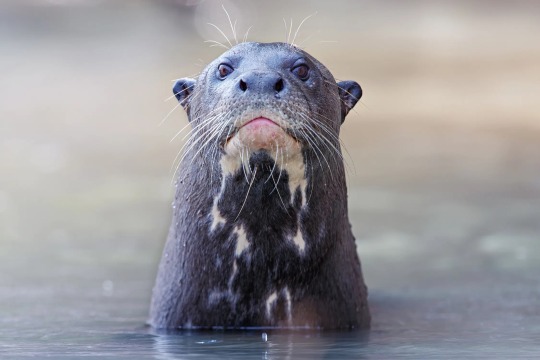

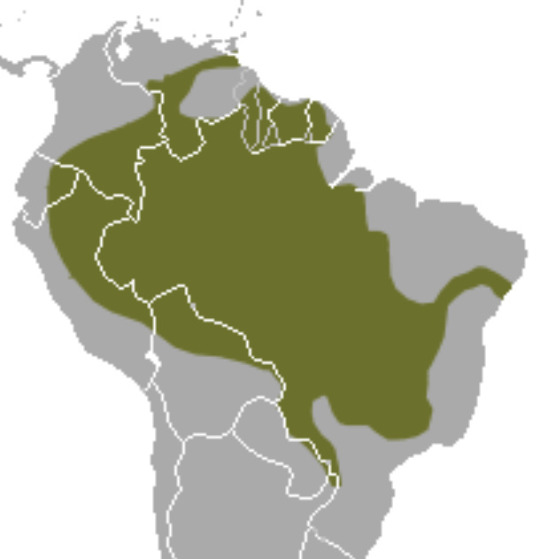
Giant river otter
Pteronura brasiliensis
Subfamily lutrinae, family mustelidae, suborder caniformia
A more well known animal this time.
These guys are social, unlike most mustelids. They live in family groups of usually 3 to 8 (can be 2 to 20 (the 20 may be that several groups were feeding together while observed)) centred around a dominant breeding pair. The roles in these groups are not rigid and the members of groups are friendly and cooperative with each other.
They are territorial though and are aggressive to otters outside the group. They work together to maim and kill intruders. Yay teamwork, isn’t that sweet.
They are very large, reaching lengths of 1.8 metres or 5 feet 11 inches.
They are endangered due to heavy poaching, mostly in the past, for their dense velvety fur.
They are diurnal and very noisy. The noisiest of all otters in fact.
They are an apex predator in their ecosystem. They mostly eat fish, but sometimes eat crabs, small caimans and snakes. Small anacondas are included in those snakes.
They will hunt together or on their own. It depends on the prey. They hunt together for caimans and anacondas.
Personally, I think they look kinda like those Japanese demons. I mean, look at that first picture.
@jackalspine @fifiibibii
15 notes
·
View notes
Note
Selkie Luz AU
Camila's and Luz's otter forms resemble the Lutra Canadensis (river otter) species but are much bigger. Luz's is about the size of a Pteronura brasiliensis (giant otter), while Camila's is almost lion-sized, like this extinct otter species found in Ethiopia.
NICE
10 notes
·
View notes
Text
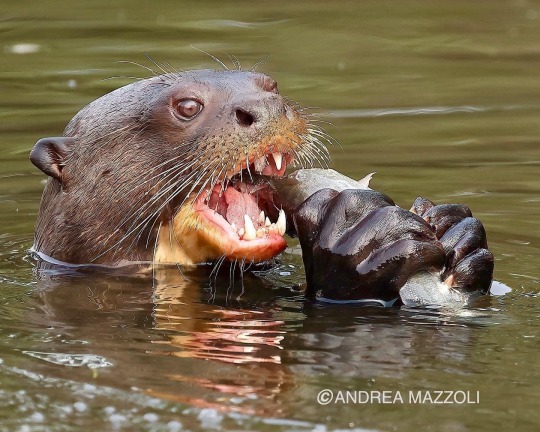
Giant Otter | Andrea Mazzoli
7 notes
·
View notes
Text



Giant Otters (Pteronura brasiliensis) - (c) SaritaWolf - please do not repost
1 note
·
View note
Text
The Giant Otter: The Amazon’s Playful Predator
The giant otter (Pteronura brasiliensis) is one of the most remarkable and unique creatures inhabiting the rivers and lakes of South America. Known for their impressive size, social behavior, and essential role in the ecosystem, giant otters captivate scientists and nature enthusiasts alike. This article delves into the biology, behavior, habitat, and conservation of these fascinating mammals,…
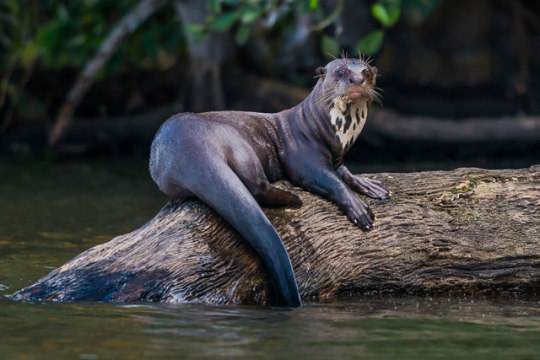
View On WordPress
0 notes

